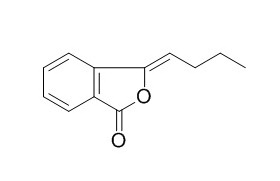(Z)-Butylidenephthalide
(Z)-Butylidenephthalide has antitumor effect, can effectively inhibit the tumor growth in the glioma.
Inquire / Order:
manager@chemfaces.com
Technical Inquiries:
service@chemfaces.com
Tel:
+86-27-84237783
Fax:
+86-27-84254680
Address:
1 Building, No. 83, CheCheng Rd., Wuhan Economic and Technological Development Zone, Wuhan, Hubei 430056, PRC
Providing storage is as stated on the product vial and the vial is kept tightly sealed, the product can be stored for up to
24 months(2-8C).
Wherever possible, you should prepare and use solutions on the same day. However, if you need to make up stock solutions in advance, we recommend that you store the solution as aliquots in tightly sealed vials at -20C. Generally, these will be useable for up to two weeks. Before use, and prior to opening the vial we recommend that you allow your product to equilibrate to room temperature for at least 1 hour.
Need more advice on solubility, usage and handling? Please email to: service@chemfaces.com
The packaging of the product may have turned upside down during transportation, resulting in the natural compounds adhering to the neck or cap of the vial. take the vial out of its packaging and gently shake to let the compounds fall to the bottom of the vial. for liquid products, centrifuge at 200-500 RPM to gather the liquid at the bottom of the vial. try to avoid loss or contamination during handling.
Eur J Pharmacol.2021, 899:174010.
Antioxidants (Basel).2024, 13(12):1530.
JMicrobiol Biotech Food Sci2021, e4289.
Nutrients.2023, 15(6):1417.
J Drug Delivery Science and Tech.2022, 67:102957.
Evid Based Complement Alternat Med.2021, 2021:5319584.
Acta horticulturae2017, 1158:257-268
Korean J. Medicinal Crop Sci.2021, 29(6):425-433
Food Chem.2019, 276:768-775
FEBS Lett.2021, 595(20):2608-2615.
Related and Featured Products
Neuro Oncol. 2011 Jun;13(6):635-48.
Local interstitial delivery of z-butylidenephthalide by polymer wafers against malignant human gliomas.[Pubmed:
21565841 ]
We have shown that the natural compound (Z)-Butylidenephthalide (Bdph), isolated from the chloroform extract of Angelica sinensis, has antitumor effects. Because of the limitation of the blood-brain barrier, the (Z)-Butylidenephthalide dosage required for treatment of glioma is relatively high. To solve this problem, we developed a local-release system with (Z)-Butylidenephthalide incorporated into a biodegradable polyanhydride material, p(CPP-SA; Bdph-Wafer), and investigated its antitumor effects.
METHODS AND RESULTS:
On the basis of in vitro release kinetics, we demonstrated that the (Z)-Butylidenephthalide-Wafer released 50% of the available (Z)-Butylidenephthalide by the sixth day, and the release reached a plateau phase (90% of (Z)-Butylidenephthalide) by the 30th day. To investigate the in situ antitumor effects of the Bdph-Wafer on glioblastoma multiforme (GBM), we used 2 xenograft animal models-F344 rats (for rat GBM) and nude mice (for human GBM)-which were injected with RG2 and DBTRG-05MG cells, respectively, for tumor formation and subsequently treated subcutaneously with (Z)-Butylidenephthalide-Wafers. We observed a significant inhibitory effect on tumor growth, with no significant adverse effects on the rodents. Moreover, we demonstrated that the antitumor effect of (Z)-Butylidenephthalide on RG2 cells was via the PKC pathway, which upregulated Nurr77 and promoted its translocation from the nucleus to the cytoplasm. Finally, to study the effect of the interstitial administration of z-butylidenephthalide in cranial brain tumor, Bdph-Wafers were surgically placed in FGF-SV40 transgenic mice. Our (Z)-Butylidenephthalide-Wafer significantly reduced tumor size in a dose-dependent manner.
CONCLUSIONS:
In summary, our study showed that p(CPP-SA) containing (Z)-Butylidenephthalide delivered a sufficient concentration of Bdph to the tumor site and effectively inhibited the tumor growth in the glioma.
Curr Drug Metab. 2012 Jun 1;13(5):524-34.
Metabolic conversion from co-existing ingredient leading to significant systemic exposure of Z-butylidenephthalide, a minor ingredient in Chuanxiong Rhizoma in rats.[Pubmed:
22554277]
Pharmacokinetic (PK) study of medicinal herbs is a great challenge, because which component(s) is(are) the bioactive ingredients is largely unknown. Most of the reported PK studies of herbs focused on the major ingredients regardless of their in vivo bioactivities, while PK of components with low content in herbs is often ignored.
METHODS AND RESULTS:
The present study demonstrates how PK study can reveal potential importance of a low content ingredient to the herbal bioactivities using (Z)-Butylidenephthalide (BuPh), a bioactive phthalide present in a significantly low quantity in medicinal herb Chuanxiong Rhizoma, as an example. PK of (Z)-Butylidenephthalide was investigated in rats using Chuanxiong extract, fraction containing (Z)-Butylidenephthalide and ligustilide, and pure (Z)-Butylidenephthalide, respectively. The results demonstrated that remarkable blood concentrations of (Z)-Butylidenephthalide were observed after administration of the herbal extract and its systemic exposure was significantly different between (Z)-Butylidenephthalide given in pure and mixed forms. More interestingly, AUC of (Z)-Butylidenephthalide via intake of fraction (9.3-fold) and extract (4.5-fold) was significantly greater than that obtained from pure Z-butylidenephthalide, which was further evidenced to be mainly due to metabolic conversion from ligustilide, a major component in Chuanxiong.
CONCLUSIONS:
Our findings revealed that although it naturally occurred in low amount, (Z)-Butylidenephthalide reached significant systemic concentrations via metabolic conversion from ligustilide.
J Pharm Biomed Anal. 2006 Mar 18;40(5):1073-9.
Optimization of pressurized liquid extraction for Z-ligustilide, Z-butylidenephthalide and ferulic acid in Angelica sinensis.[Pubmed:
16242882]
METHODS AND RESULTS:
We carried out a comparative study to evaluate PLE as a possible alternative to current extraction methods like Soxhlet and sonication for simultaneous extraction of Z-ligustilide, (Z)-Butylidenephthalide and ferulic acid in A. sinensis. The operating parameters for PLE including extraction solvent, particle size, pressure, temperature, static extraction time, flush volume and numbers of extraction were optimized by using univariate approach coupled with central composite design (CCD) in order to obtain the highest extraction efficiency. Determination of Z-ligustilide, (Z)-Butylidenephthalide and ferulic acid were carried out by means of high performance liquid chromatography with diode-array detector.
CONCLUSIONS:
The results showed that PLE was a simple, high efficient and automated method with lower solvent consumption compared to conventional extraction methods such as Soxhlet and sonication. PLE could be used for simultaneous extraction of Z-ligustilide, (Z)-Butylidenephthalide and ferulic acid in A. sinensis.



